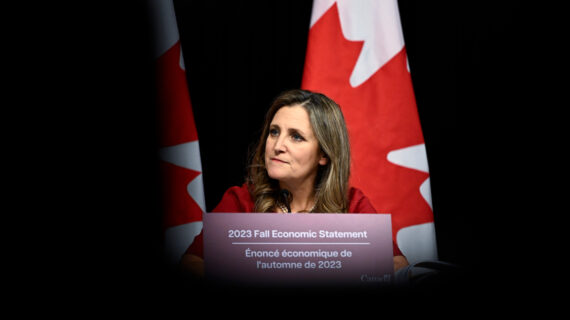In this Hub Dialogue, The Hub’s editor-at-large Sean Speer speaks to Trevor Tombe, a University of Calgary economist.
This conversation has been revised and edited for length and clarity.
Sean Speer
I am pleased to be joined for our latest Hub Dialogue by University of Calgary economist Trevor Tombe who has distinguished himself for his public spiritedness and ability to convey complex economic issues — such as equalization or carbon taxes — to a general audience.
Professor Tombe joins us to discuss fiscal policy issues in the context of the federal election campaign, including how Canadians should think about deficits, debt, and the country’s long-term fiscal sustainability.
Thank you for speaking with us, Trevor.
Trevor Tombe
Thanks for having me.
Sean Speer
Although it’s a bit challenging to discern when precisely it started and ended, there was a broad political consensus in favour of balanced budgets at the federal level at the start of this century. That consensus has since eroded due in part to the global financial crisis in 2008-09 and now the COVID-19 pandemic. In the current federal election campaign, all of the major parties have essentially reconciled themselves to ongoing deficits and growing debt accumulation.
From a policy point of view, setting aside normative or political questions, how should we think about the question of a balanced budget as an overarching fiscal policy goal? Did the past consensus overstate the importance of balanced budgets or does the new one understate their importance?
Trevor Tombe
That’s a great and complex question. There’s a lot to unpack there.
Over time, the issue of federal borrowing — by running a deficit or saving through running a federal surplus — is one that receives a lot of attention politically at some points in time and less so in others. If you look across countries, by contrast, some jurisdictions run really massive deficits, and it appears to be no issue politically there at all. The United States, for instance, has run federal deficits continuously now for 20 years — often very large, very sizable ones.
In Canada, I don’t think we should frame this question as whether it is correct or incorrect to focus on balancing the budget. But rather, like all policy choices, there are important trade-offs to consider. When you balance the budget and raise enough revenues to cover your expenditures, this means that either you increased taxes above what the otherwise would have been, or decreased spending below what it would otherwise have been to bring those two in line. And there are trade-offs to both of those options.
Looking back to the 1990s, under Jean Chrétien and Paul Martin, the federal government implemented some significant fiscal policy changes to bring us into a modest budget surplus position that lasted until the financial crisis. What makes that moment very different from the moment we’re in now is just how large the debt federally was, and how much of the federal budget went towards interest payments rather than program spending.
After the 1995 budget, at its peak, about one in every $3 of federal revenue went to interest payments. That means 33 cents of every dollar in federal taxes that a Canadian paid just went to interest on the debt. Today, that’s about 6 percent of total revenues. So, the trade-offs are very different today than we faced then, and the overall federal debt as a share of Canada’s economy in the mid 1990s was larger than it is even now after COVID-19. The trade-offs that we faced in the mid-1990s shifted policy towards the goal of balancing the budget.
Looking forward, what do we do after COVID-19? I think you’re seeing that debate unfolding in the election. Right now, the Conservatives have committed to balancing the budget over the span of a decade, which is actually a fairly modest commitment. The other parties have opted to balance the budget over a longer horizon. We’re able to manage and sustain the borrowing that we’ve done through COVID-19 and looking forward because interest rates are quite low. That means that the costs to us of servicing the debt from one year to the next is quite low. By 2025, the Parliamentary Budget Office projects that interest will only account for about 8 percent of total federal revenues, and that’s a few years down the line.
Thinking about this as an issue of not black and white, balance or not, but whether the trade-offs involved in running a deficit versus lowering spending or raising taxes are worth it, is a better way to think about this policy question.
Sean Speer
Is one of the consequences of shifting away from an overarching goal of balanced budgets as an end of itself that we might come to place a greater focus on the case for or against individual spending proposals? Will this lead us to spend more time debating whether a spending proposal is a good idea or a bad idea rather than if it will contribute to a budget surplus or a deficit?
Trevor Tombe
Evaluating whether it’s a good idea or a bad idea means assessing whether the benefits of a particular program outweigh the costs. If one wants to increase federal activity in a certain area, childcare for example, rolling it out need not actually affect the deficit if we raise taxes to pay for it.
That’s generally how I think about this: is it worth enacting new, permanent spending if it is funded through taxation? If Canadians ultimately view the benefits as exceeding the costs, then that’s entirely appropriate.
The deficit is there to bridge between good times and bad, such as borrowing money to cover emergency measures through COVID-19. Generally, it’s entirely appropriate to use public debt as a shock absorber. But that means that in good times, you need to think about bringing those debt levels back down again.
So, evaluating all policy choices like, “should we increase spending or change taxes in this area?” merely based on its implications for the annual deficit, I think, distracts from a better conversation around what are the benefits and costs of specific proposals.
Sean Speer
You’ve just described instances where deficit financing may be more justified than others, including, for instance, in the context of an emergency. Generally, economists accept that there are certain types of public investments for which deficit financing may be warranted whereas there are other types of spending where the case for depth financing is weaker. How should policymakers distinguish between these types of spending and the best means to finance them?
Trevor Tombe
There are two important types of government spending where we can think about it as potentially being more appropriate to finance through borrowing then taxation.
The first is during times of recession. In a recession, you’re naturally going to have government revenues declining because unemployment is rising and corporate profits are falling. Personal and business tax revenues are declining, people are consuming less and therefore GST revenues are lower, and EI payments and other support programs rise on the expenditure side. A deficit during a recession is a way to shift some of the shock from individuals and businesses to the government. That tends to be, economically-speaking, cheaper because the federal borrowing costs are lower than any individual or company is going to have available to them. By cushioning that load during a recession, so long as later on when you’re in an economic expansion you’re running surpluses to bring down and repay the debt that you accumulated through the recession, that’s one appropriate role for public debt.
Another scenario is to borrow to finance, longer-term investments. If there are projects that have future benefits, you can use public debt to shift some of the costs on to the future as well. So, if you’re building a new hydroelectric facility that will last for many decades, using debt in order to finance its construction allows you to better align the fiscal costs of that project with the fiscal benefits, spreading these costs over time rather than having current taxpayers foot the entire bill.
Those are two ways of thinking about potentially appropriate uses of government debt. Now, I should say, perspectives vary here. It’s tough to clearly define what is an investment that has long-term benefits. One could make the case that education has very long-lasting economic benefits –decades into the future as you’re increasing human capital. Would that mean then, that using government borrowing to fund education spending is appropriate, in the same way that one might think it is for a hydroelectric facility?
It’s not always easy to identify when it is or is not advisable to use public debt to finance different programs or projects. But thinking about it as a shock absorber and as a way to shift costs and benefits is a productive way to think about and evaluate the uses.
Sean Speer
If we’re no longer going to prioritize balanced budgets as an overarching goal of federal fiscal policy is there a still a case for some sort of fiscal anchor? And if so, what might that be, especially in light of the extraordinary fiscal position in which Ottawa currently finds itself?
Trevor Tombe
I think fiscal anchors are very important for us to have because during moments of crisis or sharp recession, a year-over-year balanced budget is often times not appropriate. So, in a recession we’ll run a deficit to cushion the blow like we’ve done during the COVID-19 shock. But then, we need to think longer term. Borrowing through the recession is one thing, but then where do we go from here?
Following the 2008-09 financial crisis, the federal government set a fairly aggressive goal of achieving a balanced budget by 2015, and it ultimately achieved that. Looking forward from COVID-19, where do we go from there? What is the target that we are aiming at? What is the anchor to which we will evaluate our current position?
There are lots of potential fiscal anchors that you can have in mind. I think one of the simplest ones to adopt is how large your debt is relative to your overall society’s ability to carry and service that debt. This is the debt to GDP ratio, and is a very common metric across countries. And, over time, one can specify a medium-term goal. This is a good way to ensure that we don’t borrow in an unsustainable way because we’re always aiming at some target that’s rooted in the economy’s capacity to manage its debt levels.
We had a debt to GDP ratio prior to COVID-19 of about just over 30 percent. Right now, it’s a little over 50 percent. So, if we were to have a fiscal anchor of getting back to pre-COVID-19 debt to GDP levels over the span of 10 to 20 years, we would need to think about how to implement tax or spending changes in order to achieve that particular goal.
The danger of not having a fiscal anchor is that it leads to always looking at the short-term. Fiscal anchors are a way to force us to think about our longer-term fiscal policy trajectory, and that’s very important. Especially now, coming out of COVID-19. But this is very important, even more so because of pressures that we’ll be facing in the coming decades: aging populations being the biggest factor that we haven’t quite come to grips with yet.
Sean Speer
That’s a great segue to my final question about fiscal sustainability. We’ve spoken about federal fiscal policy given that we’re in the middle of a federal election campaign. But when it comes to the question of long-term fiscal sustainability, the biggest challenges reside at the provincial level. Can you reflect first on this question of fiscal sustainability in Canada and how we ought to think about it? And then do you think there’s a case that we ought to be reforming our fiscal federalism to address the unsustainability challenges facing several provinces?
Trevor Tombe
This is an excellent question because it speaks to a challenge that we are going to be facing over the next few decades that is larger than COVID-19. But since it’s slow moving, it’s easy for it to fall off the radar in any given year.
If we look at Canada relative to other countries, we’re uniquely a decentralized country where provincial governments are very large and effectively run everything we think of as the main public services in the country: public education, healthcare, childcare, and community services. That means that an aging population is going to lead to pressures on health-care systems, and therefore health spending. That’s, by far, the largest source of public expenditures among provincial governments, and that is going to necessarily put pressures on their budgets. Most provincial governments are not ready for that.
Looking forward, provincial debt as a share of GDP is set to be continuously rising over whatever projection horizon you have in mind. Provincial debt is just pointed up and up and that’s not sustainable. But because the federal government is not responsible for health care directly is not as exposed to an aging population as provinces are, and Ottawa also raises a lot more of their revenues through instruments that are tied to economic growth. So structurally the federal government, when you project forward, its debt level relative to GDP is gradually declining and that is sustainable.
When we have this mismatch between the federal long-term fiscal health and provincial long-term fiscal sustainability, provincial governments would call that a fiscal imbalance and would advocate for increasing their tax room by having lower federal taxes and increasing provincial ones simultaneously, or by boosting federal transfers.
Right now, through the campaign, we’re seeing many parties, the Conservatives and NDP, for example, committing to boosting federal health transfers pretty significantly. That may be part of the solution. But we also need to think about how to rearrange our fiscal arrangements within the federation more generally, so that they’re robust in the face of this aging population and this major gap between the long-term health objectives of the federal government versus the provincial ones.
Sean Speer
Well, Trevor, thank you so much for your expertise and insight on these important issues.
Trevor Tombe
My pleasure, Sean.




